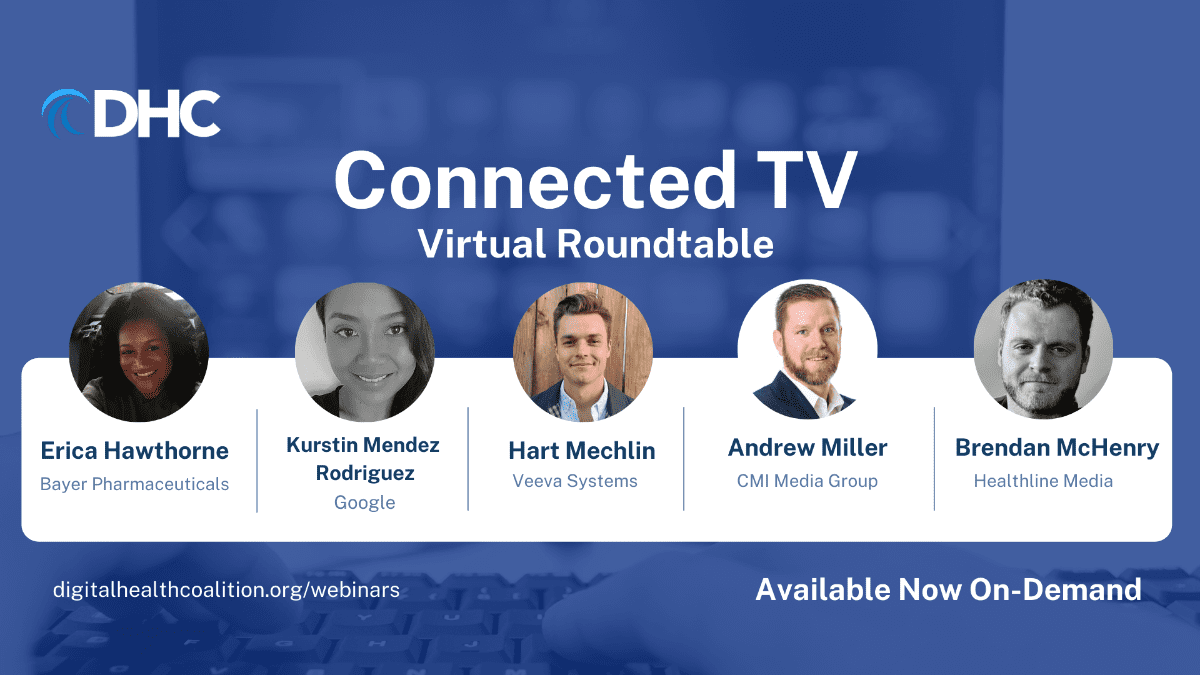Insights with Innovators
How Deeper Understanding Drives Digital Transformation, A Conversation with Bayer's Erica Hawthorne
A Conversation with Bayer's Erica Hawthorne
Earlier this month, The DHC Group had the opportunity to talk with Erica Hawthorne about what it’s like to be the Executive Director of Media Strategy for a major pharma co. after leading digital transformation for brands like Verizon and Marriott.
Erica’s approach to digital is self-described as “people-based”. Unlike some marketers who believe in pharma’s uniqueness as an industry, Erica believes it’s digital acumen that matters, not industry expertise. She espouses “as long as you understand people, then you’ll be able to reach them. You’ll be able to build the right creative, be in the right location” whether you are marketing tourism, cellphones, or life-saving medications. But she is not sure that as life science marketers we are getting it right just yet. As a relatively new member of the industry, she brings fresh encouragement that we need to make a much more concentrated effort in showing up well in the digital world where most customers are doing the majority of their brand engagement.
Technology Trends
When thinking specifically about consumers, Erica recommends ConnectedTV as one technology trend marketers really need to better understand over the next five years. As it relates to a possible cookieless future, CTV’s logged-in users are key for the “people-based” marketing approach. Audio is another area Erica sees as a potential catalyst for moving things forward. She states that prior to the pandemic audio had a bigger reach than television, is infinitely less expensive, can be tailored and target it more. Erica explains that CTV and audio are worth focusing on because “it’s going to be really critical for brands to move to people-based marketing because of the removal of cookies. And if you think about CTV, if you think about audio, a lot of that is login state. So it solves for the cookies, but it also gives you an idea of who the people are and you’ll be able to target them just as effectively, even without mobile IDs or cookies.”
While the technology is important to learn and understand, Erica emphasizes that the pharma industry needs a deeper understanding of who we are targeting – beyond their diagnosis or treatment therapy. She says, “I think that there’s a dearth between the knowledge that pharma has about its people that they’re targeting that other industries don’t have.” Erica provides an example with her own personal patient perspective. “I have a degenerative digestive disorder called Crohn’s disease. I don’t do things because I’m a Crohn’s patient. I do things because I’m me. That’s a part of my life, but I don’t want anyone to think of me as only that.”
Applying this same mindset to how they target physicians, Erica says her team observed doctors and other healthcare professionals enjoy playing games on their phones just as many consumers do. “So, we shifted strategies to gamification…because even the doctors enjoy quizzes and skill tests that we can turn into games that make them better understand the products and more likely to prescribe it.”
The Importance of Understanding
The message being delivered is equally as important, but also requires some deeper understanding of target audience behaviors and preferences. Hawthorne states “I think we need to get into more unbranded, agile, snackable, portable approaches to sharing content and sharing information.” She refers to recent insights from Google that reveal HCP desire more snackable portable content and shorter, more actionable videos.
“If you think about within pharma, we run really long videos and television commercials because of course you have to get the ISI in. And so I think that there’s an opportunity. I typically talk about unbranded for patients because you can run a 30-second unbranded drive to branded. They become aware of your brand, but it sets the right tone. They don’t care about your brand. They want to survive whatever condition they have, or treat that condition. I think in order to shorten those videos relative to the feedback from HCPs, that also, we need to think about unbranded strategies for them as well, because they want to find the right treatment. And so, if you give them the nuggets that, “Hey, this is new, this is exciting. This is differentiated.” Then we can also make sure that they go to find out about the brand. If you lead with the brand, I think it’s a flip. What’s the hook? The hook isn’t your brand, the hook is what the treatment does.”
Improving Authenticity
Related to developing a deeper understanding of our audiences is the topic of diversity and inclusion. Erica states that all patients don’t look the same and the big learning lesson is to look at each audience segment individually so that you can speak to their concerns. Using vaccine uptake as an example, Erica proposed narrowing the adherence gap by gathering feedback from patient advocacy programs, understanding the resistance for each of the audience segments to then build media that speaks to those concerns. Messaging and creative development must be authentic and relatable to target audiences. Erica asks, “Do you have African Americans in your creative? Are you speaking to their concerns? If you look at audio, the audiences that are engaged the most with audio, with radio, African Americans. Hispanics, do you have the right creative to reach them? Do you know that they’re the most engaged there? And then how do you bake into your media plan and approach to reach all audiences, which is going to end up being represented in a differentiated creative.”
Is pharma prepared for a shift in their target audience demographic? Are we able to bake diversity into our media plan to reach all audiences? Erica predicts that our target audiences are likely to continue to change and will look different in the next few decades, “…we were headed towards 2050 being a country that is a majority communities of color, primarily driven by Hispanic and African-American. So if that is the path that we’re on and we don’t connect with those two communities right now, how can we change it? Because the census from 2020 showed an uptick in that trajectory. Every demo in this country, 18 to 24 down is now majority Hispanic and African-American. Is pharma prepared? I’m not sure they are if we look at all of those things: under representation, and the business side, not a specific plan in reaching the consumers. And then the last piece with the KOLs. I think 4% of doctors in the US are African American. There are studies that show that African American patients are much less likely to take a treatment if they don’t talk to another African American professional in that office. So there needs to be more advocacy and more elevation of KOLs of color, because it will help. Some people aren’t even taking the tests to get to the prescriptions. So we talk the adherence gap, but there’s a whole group of people who haven’t even made it to the point of adhering or not adhering because they’re not testing.”

Hawthorne proposes that the future generation of pharma marketers could be the catalyst for change in diversity and inclusion that the industry needs. “They are much less likely to map into a norm that they don’t think should be a norm. They’re much more socially conscious and they are much browner…So I expect them to come in and be a sea change in every industry, not just in digital media. But every industry that they enter, I think they’re more entrepreneurial. I think that they’re more focused on representation and I think that they are more socially conscious. And so we have to be able to speak to those things. That is their norm. And I think it’s going to be a shock to systems, but in a very good way. Change is uncomfortable, but uncomfortable is where growth occurs.“
Learn More from Erica Hawthorne
A summary of a conversation with some of our industry’s leading experts on Connected TV, and the opportunities and challenges facing pharma marketers today. A live audience weighed in and participated with questions as our panelists further highlighted and addressed where there’s alignment and need for education around Connected TV. Recording and summary available.


